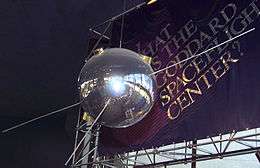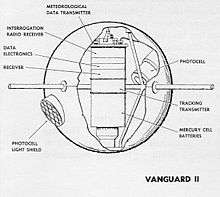Vanguard 2
 Vanguard 2 | |
| Mission type |
Weather satellite Air density experiment |
|---|---|
| Operator | Department of the Navy |
| Harvard designation | 1959 Alpha 1 |
| SATCAT № | 11 |
| Mission duration |
Weather observation: 19 days Atmospheric density studies ongoing |
| Spacecraft properties | |
| Manufacturer | Naval Research Laboratory |
| Launch mass | 10.8 kilograms (24 lb) |
| Start of mission | |
| Launch date | 17 February 1959, 15:55 UTC[1] |
| Rocket | Vanguard - SLV-4 |
| Launch site | Cape Canaveral LC-18A |
| Orbital parameters | |
| Reference system | Geocentric |
| Regime | Medium Earth |
| Semi-major axis | 8,127.72 kilometers (5,050.33 mi)[2] |
| Eccentricity | 0.1472316[2] |
| Perigee | 560 kilometers (350 mi)[2] |
| Apogee | 2,953 kilometers (1,835 mi)[2] |
| Inclination | 32.87 degrees[2] |
| Period | 121.54 minutes[2] |
| RAAN | 251.33 degrees[2] |
| Mean anomaly | 11.85 degrees[2] |
| Mean motion | 11.85[2] |
| Epoch | 24 January 2015, 14:43:44 UTC[2] |
| Revolution number | 38,278[2] |
| Instruments | |
|
Radio beacon Optical scanner | |
Vanguard 2 or Vanguard II is an Earth-orbiting satellite launched February 17, 1959, aboard a Vanguard SLV 4 rocket as part of the United States Navy's Project Vanguard.[3] The success of this launch was an important part of the space race between the United States and the Soviet Union. Vanguard 2 was the first weather satellite.[4][5][6] The satellite was designed to measure cloud-cover distribution over the daylight portion of its orbit, for a period of 19 days, and to provide information on the density of the atmosphere for the lifetime of its orbit (about 300 years).[6][7]
As of May 2016, Vanguard 2 was still in orbit.

Design
The spacecraft is a magnesium sphere 20 in (50.8 cm) in diameter. It contained two optical telescopes with two photocells. The sphere was internally gold-plated, and externally covered with an aluminum deposit coated with silicon oxide of sufficient thickness to provide thermal control for the instrumentation.
Radio communication was provided by a 1 W, 108.03 MHz telemetry transmitter and a 10 mW, 108 MHz beacon transmitter that sent a continuous signal for tracking purposes. A command receiver was used to activate a tape recorder that relayed telescope experiment data to the telemetry transmitter.
The power supply for the instrumentation was provided by mercury batteries.[8][9][10]
Mission results
Satellite drag atmospheric density
Because of its symmetrical shape, Vanguard 2 was selected by the experimenters for use in determining upper atmospheric densities as a function of altitude, latitude, season, and solar activity. As the spacecraft continuously orbited, it would lead its predicted positions slightly, accumulating greater and greater advance as it spiraled lower and faster due to the drag of the residual atmosphere. By measuring the rate and timing of orbital shifts, the relevant atmosphere's parameters could be back-calculated knowing the body's drag properties. It was determined that atmospheric pressures, and thus drag and orbital decay, were higher than anticipated, as Earth's upper atmosphere gradually tapered into space.
This experiment was very much planned prior to launch. Initial Naval Research Laboratory proposals for Project Vanguard included conical satellite bodies; this eliminated the need for a separate fairing and ejection mechanisms, and their associated weight and failure modes. Radio tracking would gather data and establish a position. Early in the program, optical tracking (with a Baker-Nunn camera network and human spotters) was added. A panel of scientists proposed changing the design to spheres, at least 20 inches (510 mm) in diameter and hopefully 30 inches (760 mm). A sphere would have a constant optical reflection, and constant coefficient of drag, based on size alone, while a cone would vary with orientation. James Van Allen proposed a cylinder, which eventually flew. The Naval Research Lab finally accepted 6.4-inch (160 mm) spheres as a "test vehicle," with 20 inches (510 mm) for follow-on satellites. The payload weight savings, from reduced size as well as decreased instrumentation in the early satellites, was considered acceptable for the initial launches. Afterwards, the later Vanguard rockets had some test instrumentation removed, lightening them enough for the 20 inch bodies.[11][12]
As the three Vanguard satellites are still orbiting, with their drag properties essentially unchanged, they form a baseline atmospheric dataset fifty years old and counting. Vanguard 2 has an expected orbital lifetime of 300 years.[13]
Optical scanner
The optical scanner experiment was designed to obtain cloud-cover data between the equator and 35° to 45° N latitude. As the satellite circled Earth, two photocells, located at the focus of two optical telescopes aimed in diametrically opposite directions, measured the intensity of sunlight reflected from clouds (about 80%), from land masses (15 to 20%), and from sea areas (5%). The satellite motion and rotation caused the photocells to scan the Earth in successive "lines". Separate solar batteries turned on a recorder only when the Earth beneath the satellite was in sunlight and about 50 min of data per orbit were obtained. The measured reflection intensities were stored on tape. Ground stations interrogated the satellite by signaling its command receiver, which caused the entire tape to be played back in 60 s. The tape was then erased and rewound.
For the planned 19 days of the weather experiment, the equipment functioned normally. The satellite was spin stabilized at 50 rpm, but the optical instrument's data was poor because of an unsatisfactory orientation of the spin axis.[14]
Post mission
After the scientific mission ended, both Vanguard 2 and the upper stage of the rocket used to launch the satellite became derelict objects that would continue to orbit Earth for many years. As of May 2016, both objects remain in orbit.[15][16]
See also
- Vanguard 1
- Sputnik 1
- Sputnik (rocket)
- Weather satellite
- Timeline of artificial satellites and space probes
References
- ↑ McDowell, Jonathan. "Launch Log". Jonathan's Space Page. Retrieved 7 December 2013.
- 1 2 3 4 5 6 7 8 9 10 11 "VANGUARD 2 Satellite details 1959-001A NORAD 11". N2YO. 24 January 2015. Retrieved 25 January 2015.
- ↑ "VANGUARD - A HISTORY, CHAPTER 12, SUCCESS - AND AFTER". NASA.
- ↑ "Interesting Goddard Facts and Firsts". NASA. Brian Dunbar. Archived from the original on 2015-12-25. Retrieved 2016-02-09.
- ↑ Janice Hill (1991). Weather From Above: America's Meteorological Satellites. Smithsonian Institution. pp. 4–7. ISBN 0-87474-394-X.
- 1 2 "Vanguard Project". U.S. Naval Research Laboratory. US Naval Research Lab. 2010-02-01. Archived from the original on 2015-12-23. Retrieved 2016-02-09.
- ↑ NASA, History, Chapter two, SATELLITES
- ↑ NASA, National Space Science Data Center, Vanguard 2
- ↑ Vanguard 2, astronautix.com
- ↑ Project Vanguard: The NASA History, By Constance McLaughlin Green, Milton Lomask
- ↑ C. McLaughlin Green, M. Lomask, "Vanguard, A History," Chapter 5, Battle over Vehicle Specifications. NASA SP-4202.
- ↑ NASA, National Space Science Data Center, Atmospheric Density Values from Satellite Drag Measurements
- ↑ NASA, National Space Science Data Center HeaderSatellite Drag Atmospheric Density, Mission Vanguard 2
- ↑ NASA, Optical Scanner, Mission Name: Vanguard 2
- ↑ "Vanguard 2 - Satellite Information". Satellite database. Heavens-Above. Retrieved 2016-05-05.
- ↑ "Vanguard 2 Rocket - Satellite Information". Satellite database. Heavens-Above. Retrieved 2016-05-05.